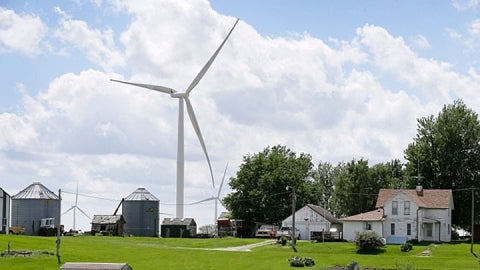Note: Yale School of the Environment (YSE) was formerly known as the Yale School of Forestry & Environmental Studies (F&ES). News articles and events posted prior to July 1, 2020 refer to the School's name at that time.

Americans’ attitudes about environmental issues aren’t simply polarized into pro- and anti-environment, but rather are spread across a diverse spectrum, a new study from the Yale School of Forestry & Environmental Studies and The Associated Press-NORC Center for Public Affairs Research finds. According to the study, attitudes about environmental issues are influenced by a combination of experience, interaction with natural environments, and religious and political views about the responsibilities of humankind as a whole, and government in particular.
The study, “Public Opinion and the Environment: The Nine Types of Americans,” identifies the following segments of the American population who each have a distinct set of environmental attitudes:
The study, “Public Opinion and the Environment: The Nine Types of Americans,” identifies the following segments of the American population who each have a distinct set of environmental attitudes:

“The broad labels of ‘pro-environment’ and ‘anti-environment’ don’t really apply to the large majority of Americans,” said Trevor Tompson, director of The AP-NORC Center. “This study offers new insight into the American public’s perception of their environment, and how that perception is affected by a host of other factors including socioeconomic, political, and religious beliefs.”
Some of the key characteristics of each group include:
“This study provides a new framework for understanding the diversity of American views and relationships with the natural world, and how those views affect environmental behavior, lifestyles, and policy preferences,” said Anthony Leiserowitz, a faculty member at F&ES. “A particularly interesting finding is that ‘green’ attitudes are not the only drivers of some pro-environmental behaviors. Some ‘anti-environmental’ groups also report high rates of energy saving actions, but do so primarily for pocketbook, not environmental reasons.”
The study was conducted as part of a partnership between Yale and the Associated Press-NORC Center for Public Affairs Research. In an earlier poll, the partnership reported that most Americans say the U.S. should take a leadership role in combating global warming, but that Americans tend to place a low priority on addressing global warming when compared with other environmental concerns.
The AP-NORC Center is a collaboration of the Associated Press and NORC at the University of Chicago. Created in 2011, the center taps into the power of social science research and the highest-quality journalism to bring key information to people across the nation and throughout the world.
Some of the key characteristics of each group include:
- Liberal Greens: Nine percent of the American public, of which 66 percent consider themselves environmentalists. Liberal Greens are very worried about, and highly interested in, environmental issues. Despite their engagement with these issues, however, they generally do not consider themselves to be outdoors people.
- Outdoor Greens: Ten percent of the American public, and a majority consider themselves to be environmentalists. Outdoor Greens are worried about environmental issues and feel strongly interconnected with nature. They tend to spend a lot of time outdoors.
- Religious Greens: Fourteen percent of the American public, and place a high importance on protecting the environment, many for religious reasons. Most think the environmental crisis is serious. They don’t tend to spend much time outdoors, however.
- Middle-of-the-Roaders: Ten percent of the American public hold a mixture of environmental opinions as they lean brown or green on various issues. Middle-of-the-Roaders are generally concerned about the environment but also like things the way they are, and tend to believe technology can solve our environmental problems.
- Homebodies: Twenty percent of the American public, Homebodies are the largest segment of the population. They do not consider themselves to be environmentalists and tend towards apathy when it comes to environmental issues.
- Disengaged: Six percent of the American public, and have few opinions on environmental issues, which do not resonate with them.
- Outdoor Browns: Fifteen percent of the American public, Outdoor Browns enjoy outdoor activities but tend to believe nature primarily serves a purpose for humans. They generally lean toward anti-environmental opinions, and don’t express interest in environmental issues.
- Religious Browns: Eight percent of the American public, are highly religious, and feel the most separated from nature of any group. Religious Browns do not enjoy outdoor activities, and express strongly anti-environmental views.
- Conservative Browns: Eight percent of the American public; Conservative Browns are adamantly anti-environmentalist. Although many engage in outdoor activities, few express interest in the environment and most do not believe there is an environmental crisis.
“This study provides a new framework for understanding the diversity of American views and relationships with the natural world, and how those views affect environmental behavior, lifestyles, and policy preferences,” said Anthony Leiserowitz, a faculty member at F&ES. “A particularly interesting finding is that ‘green’ attitudes are not the only drivers of some pro-environmental behaviors. Some ‘anti-environmental’ groups also report high rates of energy saving actions, but do so primarily for pocketbook, not environmental reasons.”
The study was conducted as part of a partnership between Yale and the Associated Press-NORC Center for Public Affairs Research. In an earlier poll, the partnership reported that most Americans say the U.S. should take a leadership role in combating global warming, but that Americans tend to place a low priority on addressing global warming when compared with other environmental concerns.
The AP-NORC Center is a collaboration of the Associated Press and NORC at the University of Chicago. Created in 2011, the center taps into the power of social science research and the highest-quality journalism to bring key information to people across the nation and throughout the world.
Published
December 7, 2015